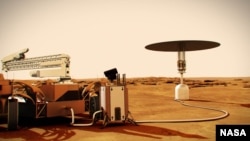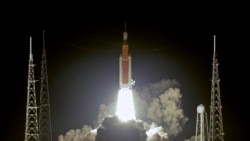The American space agency NASA is teaming up with a military research agency to develop a nuclear rocket designed to fly astronauts to Mars.
NASA recently announced it would partner with the U.S. Defense Department’s Defense Advanced Research Projects Agency (DARPA) on the effort. As the military’s research and development group, DARPA has historically helped lead many notable inventions, including the beginnings of the internet.
NASA Administrator Bill Nelson said the first nuclear-powered rocket test flight could be launched as soon as 2027.
The developing technology is called nuclear thermal propulsion. A rocket powered with this technology can travel much faster than with traditional chemical propulsion systems.
NASA has long studied nuclear thermal propulsion for possible use for space travel. But its last engine tests using the technology took place more than 50 years ago. The government ended the development program for budget reasons and because of tensions linked to the Cold War.
NASA has said with nuclear thermal propulsion, a trip to Mars could be completed in three to four months. This compares to about seven months with chemical propulsion. Building nuclear-powered rockets would permit more crewed trips and improve the safety of astronauts, the space agency says. Shorter trips would also require less equipment and other supplies.
Reducing travel times will be an important part of NASA’s future plans. It expects to increase the number of crewed flights as it seeks to send humans back to the moon by the mid-2020s and later to Mars.
Nelson said in a statement, "With the help of this new technology, astronauts could journey to and from deep space faster than ever - a major capability to prepare for crewed missions to Mars."
Nuclear thermal propulsion engines operate at a far higher energy density and are twice as efficient as rocket engines, officials say.
The U.S. Department of Energy describes on its website how a nuclear thermal propulsion system works. It needs a radioactive material like uranium and another element, such as hydrogen, in liquid form. This forms a propellant that is forced through the central part of a nuclear reactor. This causes uranium atoms to break apart inside the reactor and release heat. The heat turns the propellant into gas, which expands through an opening to produce thrust.
This kind of energy reaction, called fission, is necessary to create the extremely high temperatures needed to push heavy spacecraft during far trips.
DARPA and the U.S. Department of Energy have already been jointly developing a nuclear thermal propulsion system to be used during a demonstration test flight. In 2021, DARPA awarded money to contractors General Atomics, Lockheed Martin and Blue Origin to study designs of nuclear reactors and spacecraft.
Tabitha Dodson oversees DARPA’s efforts on the test program. She told Reuters news agency that by March, the agency is expected to choose a company to build the nuclear spacecraft for the 2027 demonstration.
NASA said it plans to continue studying and developing modern space nuclear technologies for other areas of the space program. This includes plans to put nuclear reactor power systems on the moon, and later Mars, to support future human space activities.
I’m Bryan Lynn.
Bryan Lynn wrote this story for VOA Learning English, based on reports from NASA, Reuters and Agence France-Presse.
___________________________________________________________
Words in This Story
thermal – adj. relating to heat
propulsion – n. a force that moves something forward
journey – n. a long trip
mission – n. the flight of a spacecraft to perform a task or job
efficient – adj. working well and not wasting time and energy
propellant – n. an explosive substance of fuel that causes something to move forward
thrust – n. upward push or force
____________________________________________________________
What do you think of this story? We want to hear from you. We have a new comment system. Here is how it works:
- Write your comment in the box.
- Under the box, you can see four images for social media accounts. They are for Disqus, Facebook, Twitter and Google.
- Click on one image and a box appears. Enter the login for your social media account. Or you may create one on the Disqus system. It is the blue circle with “D” on it. It is free.
Each time you return to comment on the Learning English site, you can use your account and see your comments and replies to them. Our comment policy is here.











Forum